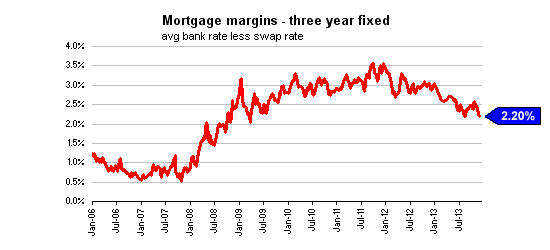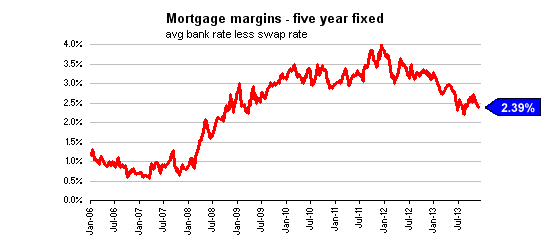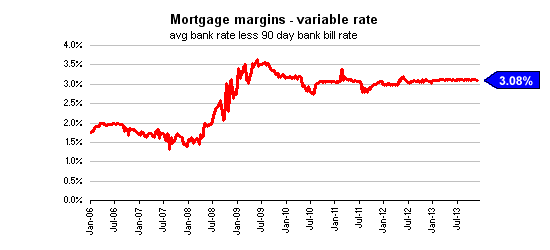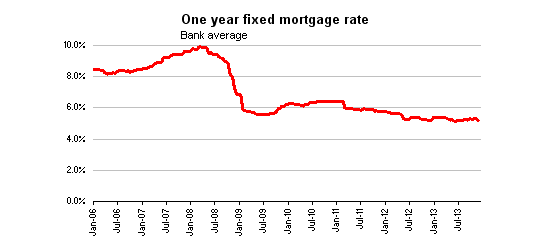
For the first time since November 2008, more than five years ago, the margin between average bank carded, or advertised, fixed-term mortgage rates and the equivalent swap rate has fallen below 2%.
Competition between banks for home buyers with a deposit of at least 20% is heating up, with the Reserve Bank restrictions on bank high loan-to-value ratio (LVR) residential mortgage lending in place, and driving bank margins lower across the curve.
This is especially true for the one and two year fixed mortgage rates.
However, margins are not falling for floating rates - and these margins are significantly higher than for the fixed rate home loans. And despite recent falls in fixed rate margins, they are still substantially higher across the board than they were between 2004 and 2008. This was the period when the previous housing boom was underway.
Interest rates themselves, however, are much lower today. The current one year fixed specials are below 5% whereas in 2008 they touched 10%.
The Reserve Bank has signalled the Official Cash Rate is likely to rise in 2014. Wholesale money markets have bid up swap rates recently, with one year swaps moving from 2.91% at the beginning of October to 3.23% today (Friday), a rise of 32 basis points over this 60 day period.
The level of housing credit is also substantially higher at the end of 2013, having reached a record $186.6 billion at the end of October. The lower bank margins are therefore on substantially larger credit bases.
Housing credit growth rates peaked in 2004 at 17% per annum, a far cry from today's 6%.






This article was first published in our email for paying subscribers. See here for more details and to subscribe.
15 Comments
Is that banker photo a distressed Grant A ?
Haha nice one KH - not one these days but in my day there were days like that.
So , given the sources of funding are the same for both fixed and floating mortages , why have floating rates not fallen?
However, margins are not falling for floating rates - and these margins are significantly higher than for the fixed rate home loans. And despite recent falls in fixed rate margins, they are still substantially higher across the board than they were between 2004 and 2008. This was the period when the previous housing boom was underway.
Greedy beggars.
US banks lament current low interest rate levels:
......the Fed’s low-interest-rate policy has been a mixed blessing for banks. Along with lowering their borrowing costs, it’s limited what they can charge on loans and earn on other investments. The difference between the two—the net interest margin—has been declining since 2010. Brian Moynihan, chief executive officer of Bank of America, told analysts on a July 16 conference call that the “sustained low-rate environment” was hitting revenue and earnings. That’s why bankers and bank stock investors have a simple wish for 2014: higher interest rates. Read more
Stephen - to answer your question the other day, looks like your typically 3yr euro borrowings swapped back into floating Kiwi currently prices about 90-100 bps over BKBM - so a touch under 4% if all were borrowed in the 3yr. Bearing in mind the funds that the bank were forced to lock into back in 2008-2012 at double that (and one bank I understand near triple that), 120-150bps funding cost abovve BKBM is about right. So somewhere in the low 4%'s but hopefully falling at least until rate hikes come. By my estimation NZ bank mortgage margins are probably curerntly somewhere in the 100-120bps range.
Thank you Grant A.
Hard to believe we were paying 10% on a 1 year fixed in 2008.
That's why we then got suckered into fixing for 5 years at 8.4%! Ouch
Then we got stung with $12,000 Break fees (so called) . Harsh.
Then we got stung with fat healthy floating margins on floating. 5.7% floating in this global environs? Overcharging!
Ha ha, they are laughing all the way to the bank. Oh that's right they're there already.
Whatever the environment - the banks get the inside wholesale information, while the man on the street gets manipulated into choosing so called "low risk" options and pays premium.
Perhaps we need a 30 year fixed like the Americans & put it to rest for good. Now, I'm sure they dont get stung for 25 years of "break fees" should they repay early?
MB - ok I'll bite - which aspect has you thinking banks did you over when in fact its clearly the market situation that did that to you and pretty much the rest of us,. Break fees ? (Comcom controls that calclation to ensure it fairly covers the cost to break and its certainly not a fee), you fixing at a high level and gifting the investor on the other side a high rate for a period ? (you weren't to know and it is the investors that gains), or "high floating rate (read the post above - what is a fair margin in your book? none I guess)
Floating should be in the low 5's carded.
Well, that was a realistic but hypothetical journey...!!
GA - how do break fees on USA longterm 30 year fixes calc? NZ/Aus formula would be a killer?
It looks like NZ banks make loads of money and if it is looked at strictly in dollar terms then perhaps they do in a relative sense. But using the true metrics being ROE/ROA, they would score a Good on the performance scale and certainly not an Excellent. I think ROE clusters around the 14-15% mark and ROA hovers somewhere around the .9 - 1.0% for the big 5 (please correct me if I'm wrong).
MikeM - youre a first, someone who actually places a few facts around bank profits rather than using the emotive stuff soem doi here. Most understand it but there are a few on here who do not realise that profits should be equate to capital/equity employed i.e. your ROE/ROA calculation that confirms banks are average to good performancers but nowhere near the high end of NZ companies making really high returns on equity/capital - you just don't see posters complaining about the likes of Restuarant Brands, Hallensteins, Michael Hill, Mainfreight etc making 20-25% plus returns over the past 5yrs compared with the banks 10-15%. Personally if someone can make high returns out of me buying burgers in a market with a store on every corner, good luck to them as it has the added advantage that the stores will/should be good quality
Detailed return data here, by bank.
I dont understand why there is such a difference between Fixed and foating rates, given my understanding that the cost of Capital for the Banks , when averaged, is much the same for each Bank.
Floating rates can be adjusted more quickly , so one would think the Banks would incentivise people to pick floats rather than fix .
Either way , banks are ripping floating - rate customers off by charging anything between 1,5 and 2% more for the floating rate
Boatman - you may be misunderstanding how banks set fixed rates. Floating rates are based on a margin over bank bill rates (2.65%), fixed rates a margin over swap rates. The RBNZ sets the OCR and therefore indirectly the bank bill rate, whereas the market solely sets the swap rates. Swap rates are effectively a market forecast of the implied future bank bill rate which is forecast to go to 5% within the next 3yrs...5.5% within 4yrs.
And they're now well higher. The 5yr swap was just below 3% back over a year ago (the time to have acted I suspect) and is now above 4.5%. Add the bank funding cost, and whatever bank credit margin onto that which competitor pressures dictate, and there's your fixed rate of near 7% compared to floating near 5.5%. Short answer, the market dictates the bulk of that difference.
@Grant A , thanks for that , I did not click onto the difference between the two calcualtions and how they influence the interest rate charged .
It makes a little more sense now.

We welcome your comments below. If you are not already registered, please register to comment
Remember we welcome robust, respectful and insightful debate. We don't welcome abusive or defamatory comments and will de-register those repeatedly making such comments. Our current comment policy is here.